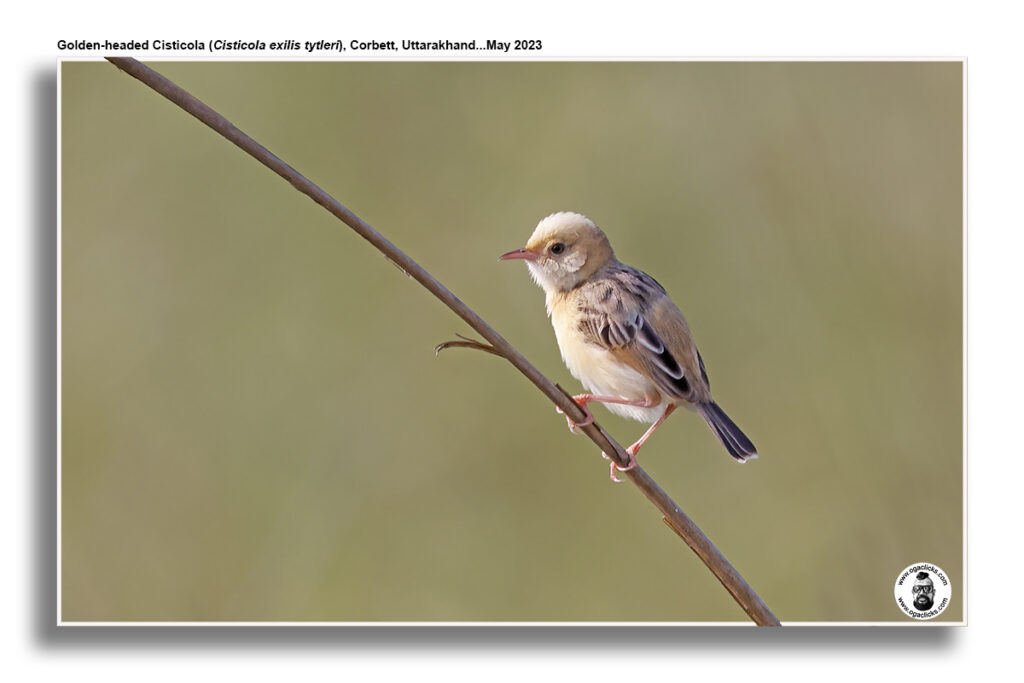
Golden-headed Cisticola Cisticola exilis
Etymology:
- Cisticola : Greek word kistos –shrub; cola – dweller
- Exilis : Latin word for Slender, Little
- Tytleri : Robert Christopher Tytler (1818-1872) British naturalist
- Erythrocephalus: Greek word eruthros red ; kephalos -headed
Vernacular Names: Hindi: Lal sir-phutki, Cachar: Titi-daotisha, Ta: Vayalan chittu, Te: Yedru-jitta, Mal: Nelpottan, Mar: Ujal Mathyacha Vatvatya
Distribution in India: Resident of Terria, North East and South Indian hills
Description: Size of 9–11·5 cm; Weight of male 7–10 g, weight of female 6–8 g. A small cisticola with streaked upperparts; rounded short tail in breeding plumage, of medium length in non-breeding plumage. The male of nominate race in breeding has golden-orange crown, face and neck. The upperparts are buffy rufous-brown, heavily streaked blackish on mantle and back, plain on rump and uppertail-coverts. The flight-feathers are brown with rufous-buff margins, upperwing-coverts are dark brown with broad buffy-brown margins. The tail is dark brown with rufous margins and narrow buffy-grey tips. It is creamy below, washed orange-buff on breast side, flanks and thighs. The iris is pale brown; bill is dark brown, pinkish base; legs are dull pink. The non-breeding male is more heavily streaked above, including on crown, rump and uppertail-coverts, tail is longer. The female is slightly smaller than male, also slightly duller and with heavily streaked crown and paler face all year. Juvenile is like non-breeding adult, but has more diffuse, browner streaks above, underparts washed lemon-yellow.
Races found in India:
Tytleri – Found in Central & South Karnataka, Tamil Nadu and Kerala. It is paler, yellowish, breeding male has pale golden-yellow crown, greyer above.
Erythrocephalus – Found in North India. It is is large, richly coloured, breeding male has deep rufous crown.
Habitat: It is found in rank grassland in savanna and woodland, bracken scrub, grassy hillsides and croplands, including rice paddies and irrigated fields; often near wetlands. It is found from Sea-level to 900 m in South India.
Food habits: It eats small insects, grasshoppers, moths and caterpillars, ants and small slugs. It occurs singly, in pairs or in family groups, sometimes in larger flocks in non-breeding season. It forages mainly on the ground, creeps among tangled grass and other vegetation.
Breeding habits: They breed in Apr–Aug in India. In aerial display, male climbs vertically, spirals upwards to a cruising height, circles for up to 5 minutes, singing, alternately fluttering and closing wings; descent rapid, near-vertical, halting just above ground; may climb straight back, or first zigzag at low level across territory. The perched male may spread and raise elongated crown feathers to exaggerate the pale cap. In India the nest is a fragile cup of fine grasses stitched on to upright broad leaf with grass stems; also builds oval nest with side entrance at top, made of grass and leaves, bound with spider webs and plant down, lined with white seedheads and other plant down. In monogamous system male collects material and delivers it to female, she builds nest. In polygamous situations male stitches together living leaves with spider webs to form shell and female (which selects nest) completes construction. The nest is placed in grass tussock or other dense vegetation, . They lay a clutch of 2–5 eggs. The incubation is done by by female for a period of 11 days. The chicks are fed by female, she swallows faeces of small chicks at nest. The nestling period is of 11–13 days. The male calls at intruders near nest, may chase off other birds near nest-site.